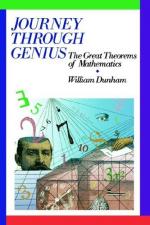
|
| Name: _________________________ | Period: ___________________ |
This quiz consists of 5 multiple choice and 5 short answer questions through A Sampler of Euler's Number Theory.
Multiple Choice Questions
1. Which of the following was a major part of Gauss' work in mathematics?
(a) Simple proofs to demonstrate Bernoulli's series.
(b) Proofs on the area of a square.
(c) Elemental proofs related to the foundations of algebra.
(d) Proofs to show that Archimedes' number theory was wrong.
2. Which of the following was an important proposition given by Euclid's number theory?
(a) Any perfect number is divisible by some composite number.
(b) Any composite number is divisible by some prime number.
(c) Numbers from one to ten are only divisible by composite numbers.
(d) Any even number is divisible by 3.
3. What did Ferdinand Lindeman prove in 1882?
(a) It is possible to find the square of a circle.
(b) That the square of a circle can not be found with a compass and a straight-edge.
(c) That the square root of the hypotenuse of a right triangle can not be found.
(d) It is impossible to find the square of a semicircle.
4. How did Archimedes demonstrate his theory of pi?
(a) He demonstrated that the area of the circle is always greater than the area of the triangle.
(b) He demonstrated that the area of the circle is neither greater than nor less than the area of the triangle and therefore must be equal to it.
(c) He demonstrated that the area of the circle is never equal to the area of the triangle.
(d) He demonstrated that the area of the circle is never less than the area of the triangle.
5. Which of the following is true in modern math about twin primes?
(a) They are infinite.
(b) We don't know if they are finite or infinite.
(c) Their sum is always another prime number.
(d) They are not considered whole numbers.
Short Answer Questions
1. What great theorem is presented by Dunham in this chapter?
2. Where was Neil's Abel from?
3. As described by Dunham, what did Archimedes demonstrate first in his proof on pi?
4. Which is one of the common notions presented in Elements?
5. What did Dunham claim about Archimedes's determination of a number value for pi?
|
This section contains 579 words (approx. 2 pages at 300 words per page) |

|




